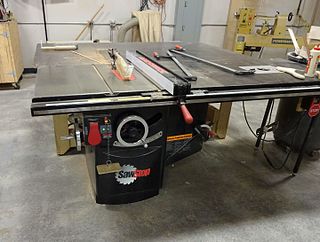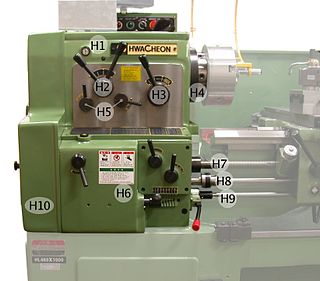
Woodworking is the skill of making items from wood, and includes cabinetry, furniture making, wood carving, joinery, carpentry, and woodturning.

The router is a power tool with a flat base and a rotating blade extending past the base. The spindle may be driven by an electric motor or by a pneumatic motor. It routs an area in hard material, such as wood or plastic. Routers are used most often in woodworking, especially cabinetry. They may be handheld or affixed to router tables. Some woodworkers consider the router one of the most versatile power tools.

A power tool is a tool that is actuated by an additional power source and mechanism other than the solely manual labor used with hand tools. The most common types of power tools use electric motors. Internal combustion engines and compressed air are also commonly used. Tools directly driven by animal power are not generally considered power tools.
A saw is a tool consisting of a tough blade, wire, or chain with a hard toothed edge used to cut through material. Various terms are used to describe toothed and abrasive saws.

A drill is a tool used for making round holes or driving fasteners. It is fitted with a bit, either a drill or driver chuck. Hand-operated types are dramatically decreasing in popularity and cordless battery-powered ones proliferating due to increased efficiency and ease of use.

A table saw is a woodworking tool, consisting of a circular saw blade, mounted on an arbor, that is driven by an electric motor. The blade protrudes through the top of a table, which provides support for the material, usually wood, being cut.

A radial arm saw is a cutting machine consisting of a circular saw mounted on a sliding horizontal arm. Invented by Raymond DeWalt in 1922, the radial arm saw was the primary tool used for cutting long pieces of stock to length until the introduction of the power miter saw in the 1970s.

A bandsaw is a power saw with a long, sharp blade consisting of a continuous band of toothed metal stretched between two or more wheels to cut material. They are used principally in woodworking, metalworking, and lumbering, but may cut a variety of materials. Advantages include uniform cutting action as a result of an evenly distributed tooth load, and the ability to cut irregular or curved shapes like a jigsaw. The minimum radius of a curve is determined by the width of the band and its kerf. Most bandsaws have two wheels rotating in the same plane, one of which is powered, although some may have three or four to distribute the load. The blade itself can come in a variety of sizes and tooth pitches, which enables the machine to be highly versatile and able to cut a wide variety of materials including wood, metal and plastic.

A biscuit joiner or biscuit jointer is a woodworking tool used to join two pieces of wood together. A biscuit joiner uses a small circular saw blade to cut a crescent-shaped hole in the opposite edges of two pieces of wood or wood composite panels. An oval-shaped, highly dried and compressed wooden biscuit is covered with glue, or glue is applied in the slot. The biscuit is immediately placed in the slot, and the two boards are clamped together. The wet glue expands the biscuit, further improving the bond.

The phrase speeds and feeds or feeds and speeds refers to two separate velocities in machine tool practice, cutting speed and feed rate. They are often considered as a pair because of their combined effect on the cutting process. Each, however, can also be considered and analyzed in its own right.

A wood shaper, is a stationary woodworking machine in which a vertically oriented spindle drives one or more stacked cutter heads to mill profiles on wood stock.

A sander is a power tool used to smooth surfaces by abrasion with sandpaper. Sanders have a means to attach the sandpaper and a mechanism to move it rapidly contained within a housing with means to hand-hold it or fix it to a workbench. Woodworking sanders are usually powered electrically, and those used in auto-body repair work by compressed air. There are many different types of sanders for different purposes. Multi-purpose power tools and electric drills may have sander attachments.

A belt sander or strip sander is a sander used in shaping and finishing wood and other materials. It consists of an electric motor that turns a pair of drums on which a continuous loop of sandpaper is mounted. Belt sanders may be handheld and moved over the material, or stationary (fixed), where the material is moved to the sanding belt. Stationary belt sanders are sometimes mounted on a work bench, in which case they are called bench sanders. Stationary belt sanders are often combined with a disc sander.
A combination machine is a woodworking machine that combines the functions of two or more separate machines into a single unit. For example, a combination machine might consist of a tablesaw with a side-mounted jointer. Another common example of this type of machine is the jointer-thicknesser which combines the function of a jointer with that of a planer.

A bridle joint is a woodworking joint, similar to a mortise and tenon, in that a tenon is cut on the end of one member and a mortise is cut into the other to accept it. The distinguishing feature is that the tenon and the mortise are cut to the full width of the tenon member.
This glossary of woodworking lists a number of specialized terms and concepts used in woodworking, carpentry, and related disciplines.
Machine – mechanical system that provides the useful application of power to achieve movement. A machine consists of a power source, or engine, and a mechanism or transmission for the controlled use of this power. The combination of force and movement, known as power, is an important characteristic of a machine.

In machine tools, a spindle is a rotating axis of the machine, which often has a shaft at its heart. The shaft itself is called a spindle, but also, in shop-floor practice, the word often is used metonymically to refer to the entire rotary unit, including not only the shaft itself, but its bearings and anything attached to it. Spindles are electrically or pneumatically powered and come in various sizes. They are versatile in terms of material it can work with. Materials that spindles work with include embroidery, foam, glass, wood, and etc.

A computer numerical control (CNC) router is a computer-controlled cutting machine which typically mounts a hand-held router as a spindle which is used for cutting various materials, such as wood, composites, metals, plastics, glass, and foams. CNC routers can perform the tasks of many carpentry shop machines such as the panel saw, the spindle moulder, and the boring machine. They can also cut joinery such as mortises and tenons.
















